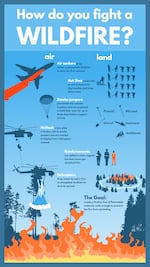A wildfire can burn more than 2,000 degrees Fahrenheit, that’s more than twice as hot as the surface of Venus. Its flames can reach more than 50 meters high.
Wildfires can get so big that they create their own weather systems, with hurricane force winds. On the ground, the average wildfire moves twice as fast as the average person can run.
How do wildland firefighters tame such an inferno?
WATCH: How We Fight Wildfires
It's been a summer of record-breaking heat and extreme drought across much of the West. Already this year, more than 43,000 wildfires have burned more than 8.2 million acres. That's about 50 percent more than the average acreage burned in the last decade.
And there’s another month of the typical fire season to come.
Sixty-five large fires are actively burning across eight states. U.S. wildland firefighters have been spread so thin that about 200 soldiers from Joint Base Lewis McChord have been called in to help. Canada, Australia and New Zealand have also sent help.
Firefighters put out most fires before they grow larger than a city block. But the 1 to 2 percent of fires that escape and become megafires are expensive — they make up 30 percent of annual costs of wildfire firefighting.
Federal, state, and local governments spend an estimated $4.7 billion a year on wildfire suppression.
-- Becca Freimuth, KCTS9/EarthFix, contributed to this report.
